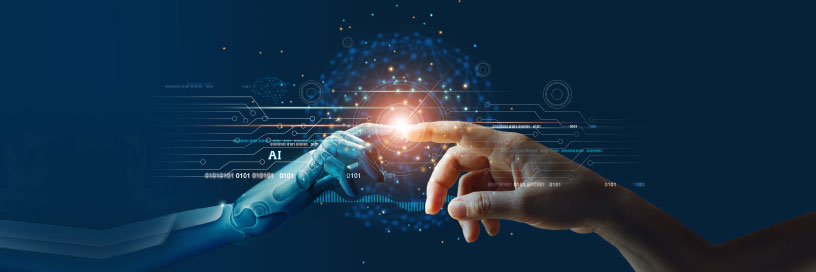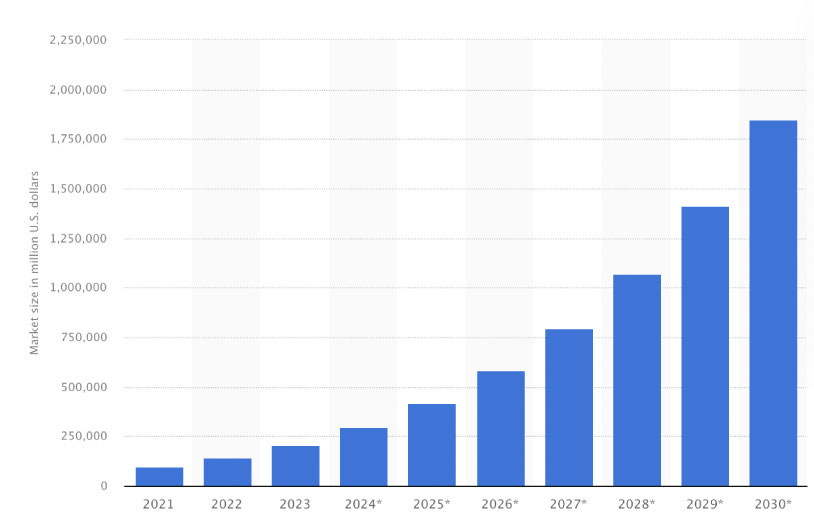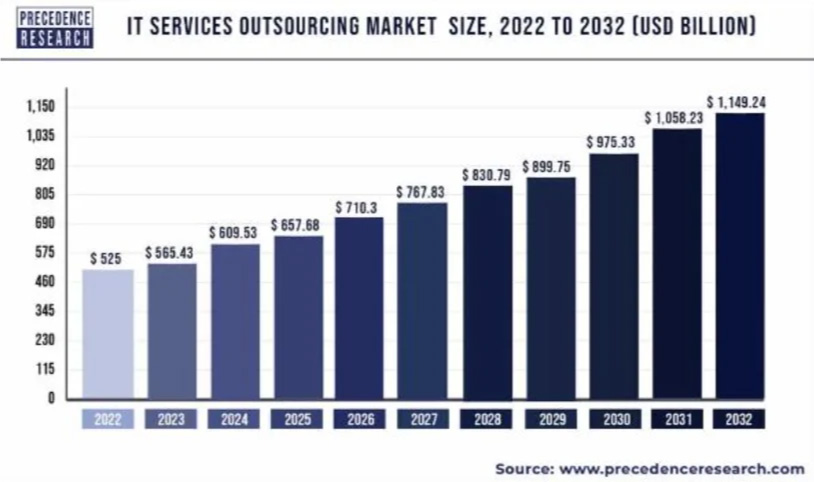In today’s corporate world, technological advancements play an essential role in drivers of progress. To stay competitive in the fast-paced business environment, companies must align themselves with the latest software versions and hardware, embracing digital transformation. The key question is not whether to implement new software or hardware, but how quickly to do so to maintain a leading edge in the industry.
Adapting emerging trends for companies aiming to provide the best quality services, Reduce cost or expense, and Improve user experiences. It’s a strategic, long-term effort that requires time, dedication, and professional expertise. However, understanding the upcoming information technology trends is essential to align them with specific business needs. This article aims to shed light on the top technology trends in 2024 and their significance, providing valuable insights for readers. So, let’s dive in!

The IT industry is the most dynamic and ever-evolving, Growing to a wide range of interests in the virtual world. Here, we highlight the latest emerging trends in information technology (IT), including a drief descriptions about them as well.
Artificial Intelligence (AI) and Machine Learning (ML) have undeniably stood out as the major breakthroughs last year.
According to the latest insights from Next Move Strategy Consulting, the artificial intelligence (AI) market is aiming for substantial growth in the coming decade. Projections indicate a remarkable surge, with the current valuation of nearly 100 billion U.S. dollars anticipated to multiply twentyfold by 2030, soaring to nearly two trillion U.S. dollars. This upward trajectory aligns with the current trend, where AI and ML continue to revolutionize various industries, from healthcare to finance, ushering in a new era of innovation and efficiency.

Today, AI and ML have become part of every field, including finance, healthcare, manufacturing, and retail. The power of AI and ML is geared towards improving, automating, and efficiently handling time-sensitive data with minimal human intervention.
By incorporating AI and ML, businesses can accelerate their processes, make well-informed decisions based on accurate insights into user behavior, enhance the overall customer experience, and deploy chatbots for seamless communication. These technologies empower organizations to extract value from vast datasets, provide valuable business insights, automate routine tasks, ensure operational safety, and augment system capabilities.
Considering integrating AI into your business? Leap by hiring skilled AI developers and unlock a realm of new possibilities for your enterprise!
Advanced or predictive analytics create a model that predicts outcomes for specific purposes, such as marketing. It blends Artificial Intelligence and statistical methods to foresee results. By examining past data, spotting patterns, and noting trends, it can predict potential future events before they occur.
This type of analytics helps in improving processes and performance, lowering risks, maximizing the use of assets, and finding more opportunities to earn revenue, among other benefits. The model can be employed to assess changing market conditions and make smart decisions, ultimately enhancing overall performance.
Both small and large companies across various industries heavily depend on the data they collect. It’s accurate to say that data is the backbone of modern life, underscoring the importance of its security. Whether through smartphones, AI devices, or industrial machines, data facilitates communication with humans and enhances our lifestyles. Today, various aspects of daily life can be translated into digital experiences through the integration of data in devices and software.
Datafication involves converting human activities into technology driven by data. This process transforms manual and labor-intensive tasks into digital processes powered by data. Using real-time information, it enables the conversion of social behavior into quantifiable data, ultimately improving the customer experience.
Over the last decade, Robotic Process Automation (RPA) has been gradually making its mark. It employs various applications and software to automate manual tasks, offering opportunities to decrease expenses through the automation of data collection, analysis, and customer service.
Beyond cost reduction, the use of bots to manage repetitive tasks allows businesses to concentrate on crucial activities. This results in a more efficient workflow and improved overall performance. Nearly 95% of companies employing Robotic Process Automation (RPA) acknowledge its positive impact on productivity.
The virtual reality gaming industry and Augmented Reality have shown that people are receptive to the idea of escaping reality. Virtual Reality (VR) and Augmented Reality (AR) are reshaping how we interact with screens, offering access to immersive and interactive experiences. It’s not surprising that the VR and AR market is expected to generate revenue of around $31.12 billion this year, with a user penetration rate of 28.8%.
Both VR and AR technologies create and enhance captivating virtual environments and real-world scenes. Virtual Reality immerses users in a computer-generated landscape through a headset, while Augmented Reality introduces digital elements into the real-world environment using a smartphone or visor.
IT outsourcing is experiencing rapid and expansive growth, and this trend is expected to persist well into the foreseeable future. Recently, outsourcing in India has emerged as the most favorable option. Today, businesses are redirecting their focus towards improving operations in centers located in India to boost profitability.
Reports indicate that nearly 64% of US businesses outsource at least one IT service, each with their specific goals in mind.
As per a report from MarketsandMarkets , the motivations behind outsourcing IT services include cost reduction, increased efficiency, and access to specialized skills. Approximately 32.2% of companies outsource to cut overall costs, while 20% aim to tap into innovation. Another 15.4% outsource to enhance the quality of their operations.
This isn’t surprising, as studies suggest that companies can achieve savings between 70 to 90 percent in their overall labor costs by outsourcing their development operations.

The IT outsourcing market is anticipated to grow significantly, reaching a size of USD 1149.24 billion by 2032, compared to its current size of USD 565.43 billion, with a Compound Annual Growth Rate (CAGR) of 8.2%. The projections indicate that this trend will continue to flourish in the coming years, as supported by statistical data.
Low code is a visual approach that facilitates a faster and more straightforward software development process. About 84% of organizations have adopted it to ease the workload of their IT teams. Low code minimizes manual coding by incorporating interactive tools, making app creation more efficient.
Utilizing built-in templates, you can easily drag and drop your preferred elements. This not only significantly improves the time-to-market but also enhances customer satisfaction through simple navigation controls.
Financial marketing stands out as the foremost user of Natural Language Processing (NLP). This technology extracts data from repositories, provides valuable insights into market sentiment, and updates on tender delays and closings.
NLP empowers computers to understand text and words in a manner similar to humans. It aids in automating processes, enabling devices to perform routine tasks independently. Some examples of NLP applications include spell checks, ticket classification, and summarization.
Large Language Models, such as ChatGPTs or Google’s PaLM, have made a significant impact on the field of artificial intelligence. If you find yourself starting from scratch and contemplating learning how to build large language models, now is the opportune time for you!
The emergence of computers and the internet has given rise to a new digital cyber sphere, where a cyberattack occurs every 39 seconds. The escalating frequency of attacks emphasizes the necessity for an effective solution. Furthermore, the age-old adage “prevention is better than cure” resonates strongly in the cyber world, where businesses incur losses of $188,400 on average for cybercrime recovery.
Cybersecurity is imperative for all internet users. Leaving your computer and virtual data vulnerable to hackers is not an option. That’s why tools like firewalls, antivirus software, and other security applications are gaining traction as developers continually enhance them with cutting-edge features.
Do you want to enhance your agility for better workload management? Look no further than cloud computing or migration! Approximately 80% of enterprises utilize multiple public or private cloud services, enabling efficient compliance processes, business operations, and data analysis.
Cloud computing integrates software, business models, platforms, and infrastructure. This integration allows you to achieve seamless adaptability, accelerate time to value, and meet the evolving demands of your industry.
It’s quite common to associate blockchain with Bitcoin, given its initial exploration by banking and financial institutions. However, blockchain extends beyond digital currency!
Blockchain is a distributed ledger technology designed to record and track transactions and assets in the corporate world. Gartner predicts that blockchain technology will generate over $3.1 trillion in business value by the end of this decade. The decentralized model effectively manages credit risk and ensures an immutable, secure, and private customer profiling system. It fosters transparency and accountability in online transactions and asset ownership.
Consider being part of the manufacturing sector. With blockchain technology, you can engineer a supply chain management system. This platform tracks goods, provides enhanced visibility to business users, and records various processes, enhancing efficiency and transparency in the supply chain.
The Internet of Things (IoT) is a network that comprises objects equipped with software, sensors, or other technical components. Its purpose is to minimize human intervention, enabling seamless connection and data exchange among these devices or objects. Given its significant potential, it’s not surprising that companies planning to invest approximately $17 trillion in IoT by 2028.
IoT offers extensive functionality by establishing a broader network, with support from technologies like Artificial Intelligence, Machine Learning, information security, and data analytics. This technology can be harnessed to develop software frameworks, create applications, and bring the final product to fruition.
Recent data from Statista reveals that IT outsourcing revenue is expected to undergo a compound annual growth rate (CAGR) of 8.07% from 2023 to 2027, reaching a value of $587.30 billion by 2027.
The growing need for enterprises to remain competitive in the rapidly changing digital landscape is a key factor propelling the expansion of offshore software development.
The substantial growth in the IT sector is largely credited to the crucial role played by outsourced software development in meeting the increasing demand. The significant costs associated with in-house software development have led businesses to opt for offshore solutions.
The Offshore Software Development Market is on track for substantial growth, projected to reach USD 283,457.5 Million by 2030. This growth is anticipated to be fueled by a robust Compound Annual Growth Rate (CAGR) of 10.13% from 2022 to 2030.
In addition, several trends, such as AI-powered development, cloud computing, the adoption of decentralized and remote team environments, and a focus on software development security, are poised to play a crucial role in the realm of offshore software development.
These trends are expected to make substantial contributions to the market’s growth, providing scalability and flexibility. The Global Offshore Software Development Market report thoroughly evaluates the market landscape, and offshore development services are anticipated to play a significant role in shaping the industry’s future.
Edge computing is likely one of the most recent and least recognized IT trends. According to Gartner, 75% of companies are expected to use Edge to create and process enterprise-generated data by 2025. Edge computing involves performing computations near the data generators at the network edge. This paradigm processes data closer to where it is generated.
The outcome is faster processing and efficient, real-time action-oriented outputs. Data from remote locations can be processed using a device or a local server. Additionally, it minimizes latency and centralizes data storage when processing occurs in data centers.
Contemporary technologies exert a profound influence on all facets of businesses today, and healthcare and medicine are no exception. While traditional digital tools like X-rays have long been used for diagnosing bone and joint defects, modern technology takes it a step further. Can you leverage technology to analyze your DNA and ward off diseases? Absolutely!
Genomics technology delves into the study of your DNA and the makeup of your genes, providing detailed mapping. This advanced approach not only streamlines the diagnosis process but also enables doctors and skilled professionals to identify potential health issues before they escalate. It encompasses technical analysis, design, diagnostics, and theoretical research to enhance medical understanding and treatment options.
The Information Technology landscape is undeniably competitive. What was once considered a groundbreaking solution can quickly become outdated. To thrive in market growth, you must stay prepared and keep up with the latest trends. In a constantly evolving digital world, numerous products and services shape the landscape, while new technologies eagerly await their debut to make a significant impact.
It’s not as daunting as it may seem. Start by identifying the potential benefits and career options that a particular technology offers. Assess if your chosen technology aligns with your goals. Getting involved in the early stages allows you to quickly embrace trending information technology and stay ahead of the curve.
Soft n Solve is here to help! We offer access to a pool of pre-vetted developers, making it easy for you to kickstart your project smoothly!
UAE
Address: Empire Heights, Burj Khalifa Block Business Bay
+971 52 8028863
Pakistan
Address: Anum Estate,Main Shahrah-e-Faisal
+92 331 3223528
Start your 7-days Risk-free trial.
This will close in 0 seconds
| [wpforms id="5045"] |
This will close in 0 seconds